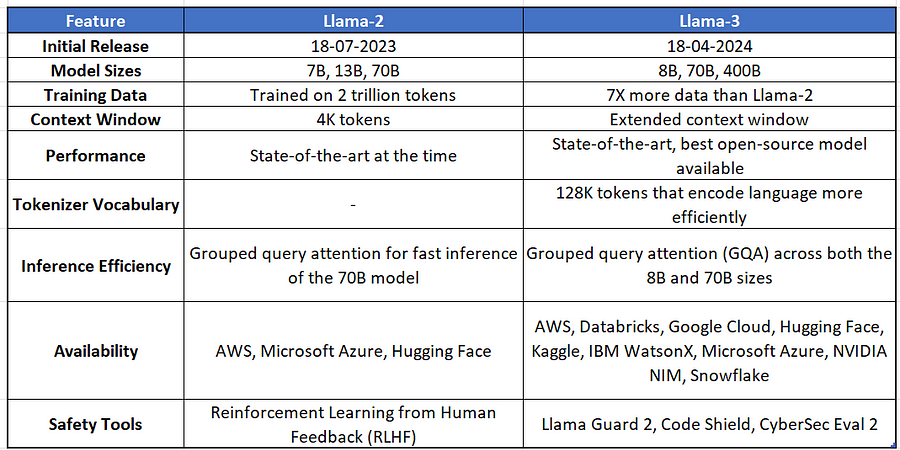
Introduction
In the ever-evolving domain of artificial intelligence, Meta’s Llama series has consistently pushed the boundaries of what’s possible with large language models (LLMs). These models have not only revolutionized the way we interact with technology but have also become a cornerstone in the development of AI applications that are increasingly intuitive and human-like.
Today marks a significant milestone in this journey as Meta proudly announces the release of Llama-3, the latest and most advanced addition to the Llama lineage. This open-source marvel stands as a testament to Meta’s commitment to democratizing AI technology, offering unprecedented capabilities that are poised to redefine the landscape once again.
The excitement within the AI community is palpable. Llama-3 is not just an incremental update; it is a leap forward, promising to deliver state-of-the-art performance that rivals, and perhaps surpasses, the best proprietary models available today. With its release, Meta is setting a new standard for open models, ensuring that the best of AI is accessible to all.
As practitioners and enthusiasts alike eagerly explore the potential of Llama-3, there is a shared sense of anticipation for the innovations that will emerge from this groundbreaking development. The future of AI is here, and it’s open for everyone.
What is Meta Llama-3?
Large Language Models (LLMs) are advanced AI systems designed to understand, generate, and sometimes translate human language. They are trained on vast amounts of text data, enabling them to perform a wide range of language-related tasks, from translation and summarization to question-answering and conversation.
Meta Llama-3 is the latest open-source LLM, representing a significant leap in the Llama series. As an open-source model, Llama-3 offers several benefits:
- Transparency: Researchers and developers can inspect the model’s architecture and training data, fostering trust and understanding.
- Collaboration: The open-source nature encourages a collaborative environment where improvements and innovations can be shared, accelerating progress in the field.
- Accessibility: It lowers the barrier to entry, allowing a broader range of individuals and organizations to experiment with and benefit from cutting-edge AI technology.
The target audience for Meta Llama-3 is quite diverse:
- Developers can integrate Llama-3 into applications, creating more natural and intuitive user experiences.
- Researchers in the field of AI and computational linguistics can explore the model’s capabilities, contributing to scientific knowledge and potential breakthroughs.
- Businesses can leverage Llama-3 to enhance customer service, automate content creation, and gain insights from data analysis.
In essence, Meta Llama-3 is not just a tool but a platform for innovation, poised to empower a new generation of AI practitioners across various industries.
Key Features and Improvements
Meta’s Llama-3 has ushered in a new era of large language models with its array of impressive features and improvements:
- State-of-the-Art Performance: Llama-3 has demonstrated exceptional performance across various industry benchmarks, setting a new standard for large language models1.
- Increased Dataset Size: The model has been trained on over 15 trillion tokens of data, which is a sevenfold increase from the dataset used for Llama-2. This massive dataset includes four times more code, enhancing the model’s comprehension and versatility2.
- Enhanced Reasoning Capabilities: Llama-3 boasts improved reasoning abilities, allowing it to understand and process complex queries and tasks with greater accuracy1.
- Extended Context Window: With an 8K context window, Llama-3 can handle inputs of around 6,000 words of context. This is double the capacity of Llama-2, enabling the model to access more information from lengthy passages for informed decision-making. This feature is particularly beneficial for tasks that require an understanding of long documents or conversations.

These advancements make Llama-3 not just a tool, but a transformative platform for developers, researchers, and businesses looking to harness the power of AI.
Benefits and Use Cases
Meta Llama-3 is not just a technological marvel; it’s a catalyst for innovation and progress in the AI community. Here are some of the benefits and use cases:
Broad Range of Applications: Llama-3 is adept at a variety of tasks, including but not limited to:
- Code Generation: Automating the writing of code, which can significantly speed up the development process1.
- Content Creation: Assisting in generating articles, stories, and even poetry, providing a creative partner for writers and marketers2.
- Research Tasks: Facilitating data analysis, summarization, and complex problem-solving, thereby becoming an invaluable tool for researchers1.
- Potential for Innovation and Development: By providing an open-source platform, Llama-3 invites the global AI community to contribute to its evolution. This collaborative approach accelerates innovation and leads to rapid advancements in AI applications2.
- Democratization of AI Technology: Llama-3 embodies the principle of making cutting-edge AI technology accessible to everyone. This democratization allows individuals and businesses, regardless of size, to leverage AI for their benefit.
The release of Meta Llama-3 is a significant step forward in the AI landscape, offering a versatile tool that can adapt to a multitude of scenarios, pushing the boundaries of what’s possible with AI.
Getting Started with Llama-3
Getting started with Meta Llama-3 is a straightforward process, thanks to its availability on various platforms and the wealth of resources provided to help users harness its capabilities.
Accessibility: Llama-3 models are readily accessible on major platforms such as AWS, Databricks, Google Cloud, Hugging Face, Kaggle, IBM WatsonX, Microsoft Azure, NVIDIA NIM, and Snowflake1. This wide availability ensures that developers, researchers, and businesses can easily integrate Llama-3 into their workflows, regardless of their preferred development environment.
Resources for Further Information:
- Official Documentation: For comprehensive guidance on getting started with Llama-3, the official Meta Llama website provides detailed documentation, including a getting started guide, FAQs, and a responsible use guide.
- Tutorials: There are various tutorials available, such as those on TorchTune, which offer step-by-step instructions on downloading, fine-tuning, and evaluating Llama-3 models.
- GitHub Repository: The official Meta Llama 3 GitHub site is a valuable resource for developers looking to explore the model’s codebase, contribute to its development, or simply learn from its implementation.
Whether you’re a seasoned AI practitioner or just starting out, these resources will help you make the most of Llama-3’s capabilities and contribute to the exciting field of AI.
Conclusion
As we conclude our exploration of Meta’s Llama-3, it’s clear this large language model represents a significant leap in AI development. Its state-of-the-art performance and open-source nature highlight its potential to drive progress across multiple domains.
Looking ahead, we anticipate further advancements building upon Llama-3’s foundation, leading to more sophisticated models seamlessly integrating into our daily lives, enhancing everything from education to healthcare.
The invitation to explore Llama-3 is open to all, offering opportunities for developers, researchers, and AI enthusiasts alike to unlock new possibilities and spark creative solutions.
Let’s embrace Llama-3’s spirit of innovation and collaboration, pushing the boundaries of what’s possible and shaping a future where AI enhances every aspect of our lives.
